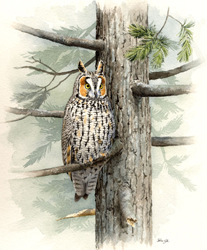Breeding Bird Atlases (BBA)
Find a Bird - BBA1
Breeding Bird Atlas 1 Species Accounts
Long-eared Owl
Asio otus
State Status
Special Concern
Egg Dates
March 15 to May 14
Number of Broods
one; may re-lay if first attempt fails.

Although the Long-eared Owl is a permanent resident in Massachusetts, it is seldom encountered except during migration and winter, when it is most often seen inconspicuously roosting in a conifer or dense thicket. Formerly more common, the species has always been encountered most frequently in the eastern portions of the state, especially the Southeast. During the Atlas period, confirmations were made only on Martha’s Vineyard and Cape Cod.
Spring migration of birds that winter south of Massachusetts occurs mainly during March and April. It is not known to what extent the state population is migratory. Local breeders are on territory by February, but there is a variation in the dates when nesting is initiated. During the courtship period, males offer the female food, but little else appears to be known about courtship activities.
Although infrequently heard in our area, the most familiar call is a mournful hoot uttered singly or in a short series. Near the nest, a variety of vocalizations are heard, including a low-pitched kitty-kitty-kitty, cries of distress, yaps, prolonged shrill squeals, whistles, chuckles, snorts, and raspy hisses. Many of these calls are ventriloquial. Bill snapping is also performed.
For nesting, this species generally appropriates an old squirrel, crow, or hawk nest, from 10 to 40 feet high, located in a thicket, grove, or woodlot. Rarely, the nest is in a low shrubby growth or on the ground. Seven southeastern Massachusetts nests were located as follows: 1 in an old squirrel nest at 20 feet in a Pitch Pine in swampy woods and 6 in White Pines in low-growth deciduous woods, mixed forest, or dense pine woods. Of these last 6 nests, 2 were old crow nests and 4 were old hawk nests. Heights ranged from 25 to 40 feet (ACB). During the Atlas period, all of the nests on Martha’s Vineyard were in old crow nests in Red Pine plantations (Ben David). The Cape Cod nest (original occupant unknown), constructed of sticks with some oak leaves and pine needles, was located at 40 feet near the top of a Pitch Pine in a pine grove surrounded by swamps (Wood).
The eggs are generally laid in March or April, but a record of six young averaging a week old on March 26 at a nest in Burlington (EHF) indicates that laying may sometimes occur as early as late February. If the birds renest, hatching may not occur until late May. Clutches consist of three to eight (usually four or five) oval glossy-white eggs laid at 48-hour intervals. Clutch sizes in 3 Massachusetts nests were three, four, and five eggs (ACB, DKW). Incubation by the female lasts 26 to 28 days, and the eggs hatch about 2 days apart. Occasionally, the last young hatched are killed and eaten by the older nestlings.
Once the young hatch, the adults boldly defend them with weird, piercing screams, anguished cries, and distraction displays. When an intruder approaches the nest, one or both parents may fly off and plummet to the ground. Immediately, a shrill cry is uttered, accompanied by a great rustling and rattling of feathers, as though the owl were struggling with prey. When the enemy has been decoyed away from the young, the performing bird begins moving away, still holding its wings partially open, as if the imaginary prey were too large to carry off, and eventually flies off to circle back to the young.
Brood size in nests in Massachusetts ranges from three to six young. Pairs on Martha’s Vineyard generally reared at least three young to fledging age (Ben David). At the Cape Cod nest, three nestlings fledged in 1976 and four in 1977 (Wood). Nestling dates in Massachusetts range from March 20 to June 3 (EHF, ACB, Wood). The young leave the nest about 23 to 26 days after hatching but are incapable of sustained flight until they are about 34 days old. Their parents feed them for some time, and the family group stays together for the rest of the season and perhaps into the winter.
The most complete recent nesting chronology for Massachusetts is that of the Cape Cod pair. In 1976, the female was discovered on the nest on May 3, three large nestlings were seen on May 28, and these fledged about June 4. In 1977, breeding at this site commenced somewhat earlier, with the female on the nest by March 21. The four nestlings were estimated to be 3, 5, 7, and 9 days old on April 28, at which time the two youngest owlets were returned by human intervention to the dilapidated nest from which they had fallen. Fledging occurred about May 15, and one owlet was lost to a predator a few days later. The family was still intact in late August. In 1978, the birds were at the nest site by February 25, but the nest was in complete disrepair and was not reused (Wood).
Though Long-eared Owls consume many small mammals such as voles, mice, shrews, rats, and squirrels, they have also been known to take birds, including some as large as quail. Small numbers regularly migrate in October and November, and during the winter months they often roost communally along the coast near marshes or streams, or near broad expanses of open fields. These roosts are often in groves of Red or White pine, or stands of Red Cedar, as well as in thickets of low-growing shrubs.
The Long-eared Owl is listed as a species of special concern in Massachusetts
Map Legend and Data Summary
Atlas 1 data collected from 1975-1979


Note: very rare in southeastern coastal regions; sparse and possibly overlooked elsewhere
Helen C. Bates



